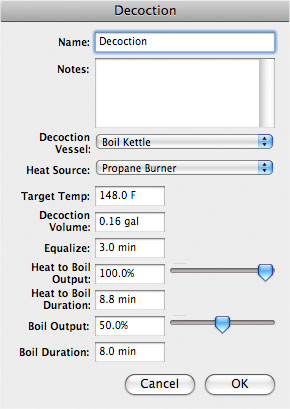Decoction: Difference between revisions
(→Notes) |
(→Notes) |
||
| Line 15: | Line 15: | ||
==Notes== | ==Notes== | ||
This is a technique developed by old style European brewers for brewing lager beers. Mostly used on undermodified malts that can't fully convert the starches to sugar. Boiling the grains for a short time, 10 mins. will reduce the size and complexity of malt starch and protein molecules and make them more convertable into sugars for the yeast to eat, and make a clearer beer. It will also raise your effiency. It will give the beer slightly more color, and a deeper malt flavor, creating a compound called melonoidin. Think of searing a steak on a grill. | This is a technique developed by old style European brewers for brewing lager beers. Mostly used on undermodified malts that can't fully convert the starches to sugar. Boiling the grains for a short time, 10 mins. will reduce the size and complexity of malt starch and protein molecules and make them more convertable into sugars for the yeast to eat, and make a clearer beer. It will also raise your effiency. It will give the beer slightly more color, and a deeper malt flavor, creating a compound called melonoidin. Think of searing a steak on a grill. | ||
With highly modified malts such as those in the U.S., only a protein rest and a single decoction 33-40% of the thick mash, raising to saccarification rest may be sufficient. | With highly modified malts such as those in the U.S., only a protein rest and a single decoction 33-40% of the thick mash, raising to saccarification rest may be sufficient. Bring the malt up to boiling gently by stiring and 50% of your heat output to avoid scorching. You can use a strainer to pull out the thick malt, with only enough liquid to cover it. Note your data in the decoction box in BTP. | ||
Jamie W. | |||
Revision as of 01:11, 16 January 2007
Decoction is a way to raise mash temperature by removing a portion of the mash, heating it,and returning it to the mash vessel.
See also
Notes
This is a technique developed by old style European brewers for brewing lager beers. Mostly used on undermodified malts that can't fully convert the starches to sugar. Boiling the grains for a short time, 10 mins. will reduce the size and complexity of malt starch and protein molecules and make them more convertable into sugars for the yeast to eat, and make a clearer beer. It will also raise your effiency. It will give the beer slightly more color, and a deeper malt flavor, creating a compound called melonoidin. Think of searing a steak on a grill. With highly modified malts such as those in the U.S., only a protein rest and a single decoction 33-40% of the thick mash, raising to saccarification rest may be sufficient. Bring the malt up to boiling gently by stiring and 50% of your heat output to avoid scorching. You can use a strainer to pull out the thick malt, with only enough liquid to cover it. Note your data in the decoction box in BTP.
Jamie W.
